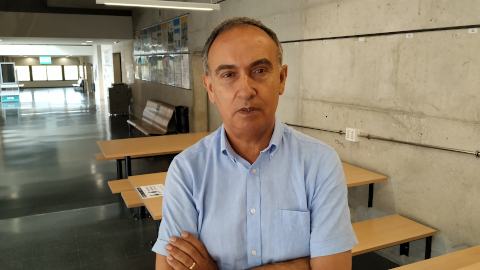"We find it feasible to test the concept vaccine we are creating to fight SARS-CoV 2 at the end of the year"

Francesc Gòdia, professor of the Department of Chemical, Biological and Environmental Engineering at the UAB and director of the Cellular Engineering and Bioprocesses Group, is one of the main driving forces behind the study to find a Covid-19 vaccine at University; a study conducted thanks to a fundraising campaign. Participating in this innovative and cross-curricular research are experts from different UAB groups and other UAB-affiliated research centres and hospitals.
31/07/2020
"We have a network of highly prepared research groups providing valuable proposals in the field of vaccines. Now more than ever they need our full support."
- What makes your research unique?
- The combination of tools belonging to biology and engineering within one same group and in a highly multidisciplinary manner, helps us to advance comprehensively in several aspects, from the more basic to scale-based production. That makes the final solutions and products we propose in our research to include elements that will make their manufacturing, and particularly their quality aspects, quick and easy to begin working on.
- What are the differences between the vaccine you propose and others that already are being tested, such as the Oxford or Moderna vaccines?
- This vaccine is basd on Virus Like Particles or VLPs. These particles resemble the virus, because they have a similar 3D structure presenting the antigens that trigger the production of antibodies, but they do not have the genetic material in the interior. That makes them immunogenic particles, i.e. capable of inducing an immune response, but at the same time inefficient and, therefore, safe. The particle nucleus comes from another virus, in fact, and we make them function so that the antigens can position themselves on the exterior, in this case the S protein from the SARS-CoV-2 virus. In the case of Moderna, the vaccine is based on RNA, while the Oxford vaccine is based on a modified adenovirus.
- How far along is the project? Where are you at this moment?
- Our groups has been working on this concept of VLP-based recombinant vaccines for 8 years now. Since the pandemic began, we started working on what we can the "functionalisation" of the VLPs, through the cell surface expression of the antigen we are interested in. This part is done in cell cultures of the HEK 293 cell, in which we introduce or co-transfect the genes which permit the production of VLPs. Now we have covered this whole part and have ended up with the experimental proof that we are capable of obtaining these VLPs which are useful against Covid-19. After this we must verify that the VLPs are recognised by neutralsing antibodies and that they can generate them. The next step then will be production in bioreactors and purification at a large enough scale so as to try the VLP-based vaccines on animal models.
- Does the study have a deadline?
- We find it possible to start the proof of concept studies on animal models at the end of 2020 or start of 2021.
- What would you say to those who think that with so many other projects underway, there is no need to invest in yet another one?
- I would tell them that today science is advancing thanks to multiple parellel efforts, in which the findings of one project, whether negative or positive, also help the rest of projects. Biological systems are extremely complex and the more questions made by more groups, more knowledge is generated and we are all quicker to progress. At a time like this, in which there is a huge need for the development of a Covid vaccine, the more intelligence, research effort and projects underway, the faster we advance towards our objective.
- For what has the money raised until now for the UAB vaccine project been used?
- At the moment, individual donations collected under the UAB crowdfunding campaign are still in the collection phase and will be used in the more expensive project phases, such as the tests with animal models, which require high biosecurity levels. The funding will be of great help to us there.
- Are there other sources of investment, in addition to the donations made?
- Yes, actually, since we began working we are the ones who have provided the resources from our own research groups, both in terms of material and reagents, and in personal resources. Individual donations are complementary funding.
- What would you say to public authorities, entities or businesses to receive their support and continue to work on developing your proposal?
- I would tell them that we all have the social responsibility to accelerate research into a Covid-19 vaccine. I would tell them that we must be active from our different positions and that, in particular, we have a network of highly prepared research groups providing valuable proposals in the field of vaccines, and that this is the moment to give them all the support possible. Together we will achieve more resources for research in this field and the ability to develop products which go all the way to the final stage and manage to improve health protection for everyone.
Related news: Coronavirus vaccine is the objective of a UAB crowdfunding campaign
This information is related to the following SDG
Good health and well-being